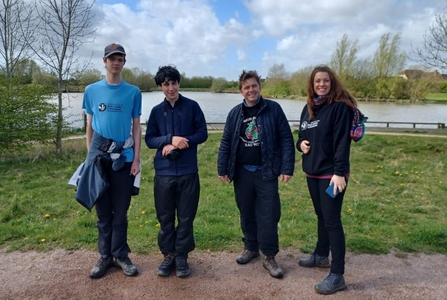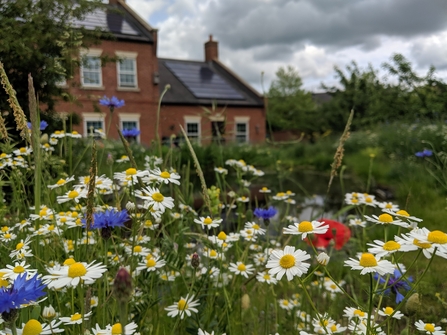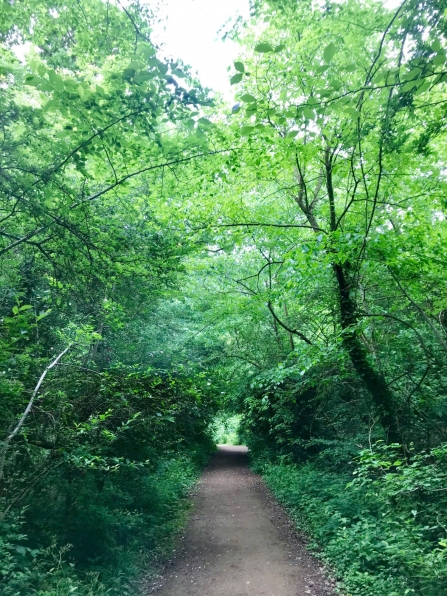On the 5th April 2024, I met the mayor of Cambridgeshire and Peterborough with Ionathan, another member of the Wildlife Trust BCN Young Persons Forum, and Communities and Wildlife Officer Alison. Overall, this meeting was a success and gave a good insight into the operations of the combined authority and what they are responsible for. The main topics we discussed were transport and peat degradation, but we also discussed housing development, insulation and energy from waste (EfW).
Meeting the Mayor of Cambridgeshire and Peterborough to discuss progress towards a greener Cambridgeshire
A path through Oaks Wood by Ruth Algar

Organisation
Nik Johnson had expressed an interest in the Young Person’s Forum, so Alison arranged a meeting for the 5th April. This meeting followed a previous meeting we had with Daniel Zeichner (blog here).
Preparations
The Combined authority has budgets for greener farming, transport and housing, and these areas have environmental impacts which are of interest to the young person’s forum. The combined authority’s climate change committee published a report with recommendations on the actions the authority should take to enable the green transition in Cambridgeshire and Peterborough. To prepare for the meeting, I made notes on this report and based the agenda of the meeting on this. Reading this enabled me to direct more relevant questions to increase the productivity of the meeting.
Planning the structure of the meeting
Alison, Ionathan and I met in Cambourne around 30 mins before Nik Johnson was scheduled to arrive to discuss how we were going to structure the meeting. We decided to start with some small talk about how he was getting on in general, and what projects he had recently undertaken and then build it up to the agenda items. This was because he was on leave, and we did not know how much research he had been able to conduct. Preparing the structure improved the flow of the meeting, and this was one area of significant improvement compared to the meeting in January with Daniel Zeichner.

Wildflowers in the Manor House garden by Rebecca Neal
The meeting
When Nik Johnson arrived, we initially had some general discussion about nature such as ‘what bird would represent Cambridgeshire?’ and ‘what he had done for nature recently?’.
We moved on to discuss the items on the main agenda which included peat degradation, transport, emissions from housing and EfW (Energy from Waste).
Peat degradation
Peat degradation is a serious environmental issue in Cambridgeshire, which is responsible for around 33 percent of Cambridgeshire’s annual greenhouse gas emissions, loss of wildlife habitats and loss of profit for farmers. This is why we asked him a series of questions on how this issue was going to be solved. His responses were:
- The recommended £50,000 a year to the peat committee (which is responsible for peat conservation such as rewetting schemes) has been delivered and he said there are plans to increase this.
- The combined authority is providing funding to fenland soil, which is a charity working on ‘whole farm’ policies to help farmers to farm peat more sustainably to reduce carbon dioxide emissions from it. In terms of the responses from farmers, these are largely positive, particularly from the farmers whose profits are being harmed the most from soil degradation and climate change.
Transport
Transport
Carbon dioxide emissions from transport are high in Cambridgeshire and Peterborough, particularly in rural areas where cycling and public transport are much less widely available. Since the transport is a responsibility of the combined authority, this was another discussion point at the meeting. His responses were:
- To make bus services more widely used he mentioned the plan to bring the bus services under public ownership to increase the efficiency of the service and make the service operate in a way that helps the people of the county, rather than for profit. This will mean companies cannot just cut bus routes as they please, hence encouraging more people to use the bus services instead of cars to reduce transport emissions.
- The report mentioned a target for all electric buses subsidised by the authority to be electric by 2025. He said there has been progress on this and electric buses being added to the routes subsidised by the combined authority, and he said the authority would push for more progress in this matter.
- When we asked him about cycle parking and cycle routes, he said that they want to improve them to encourage more people to cycle, but that funding is always tight.
Emissions from buildings
We then asked him about upgrading buildings to lower domestic greenhouse gas emissions from buildings, and he said that money has been put aside to do this. Homeowners would also be pleased because it would lower their energy bills significantly. However, he highlighted the problem of transparency, and they would have to rigorously show where the money was going to avoid scandals, such as the SNP finances scandal. Another problem he mentioned is that councils are struggling to find anyone to do the practical task of installing heat pumps and insulation.
EfW (Energy from Waste)
Lastly, we discussed Wisbech Energy from Waste (EfW), a large waste incinerator which was approved by the department of net zero. He said he and the residents of Wisbech opposed this. I asked him if it would be fitted with CCS (Carbon Capture and Storage) as the report outlined that all new EfWs built should be fitted with CCS, but he said he was not sure whether this had been done. I wanted to ask him more questions on this matter, but time was running out and he had to go.

A path through Oaks Wood by Ruth Algar
Summary
Overall, it was a successful meeting, and it gave a good insight into the actions of the combined authority, and how it will help Cambridgeshire make the green transition in the next few years. It was interesting to hear about where progress had been made and what still needs to be done to reduce Cambridgeshire’s greenhouse gas emissions and achieve net zero.

